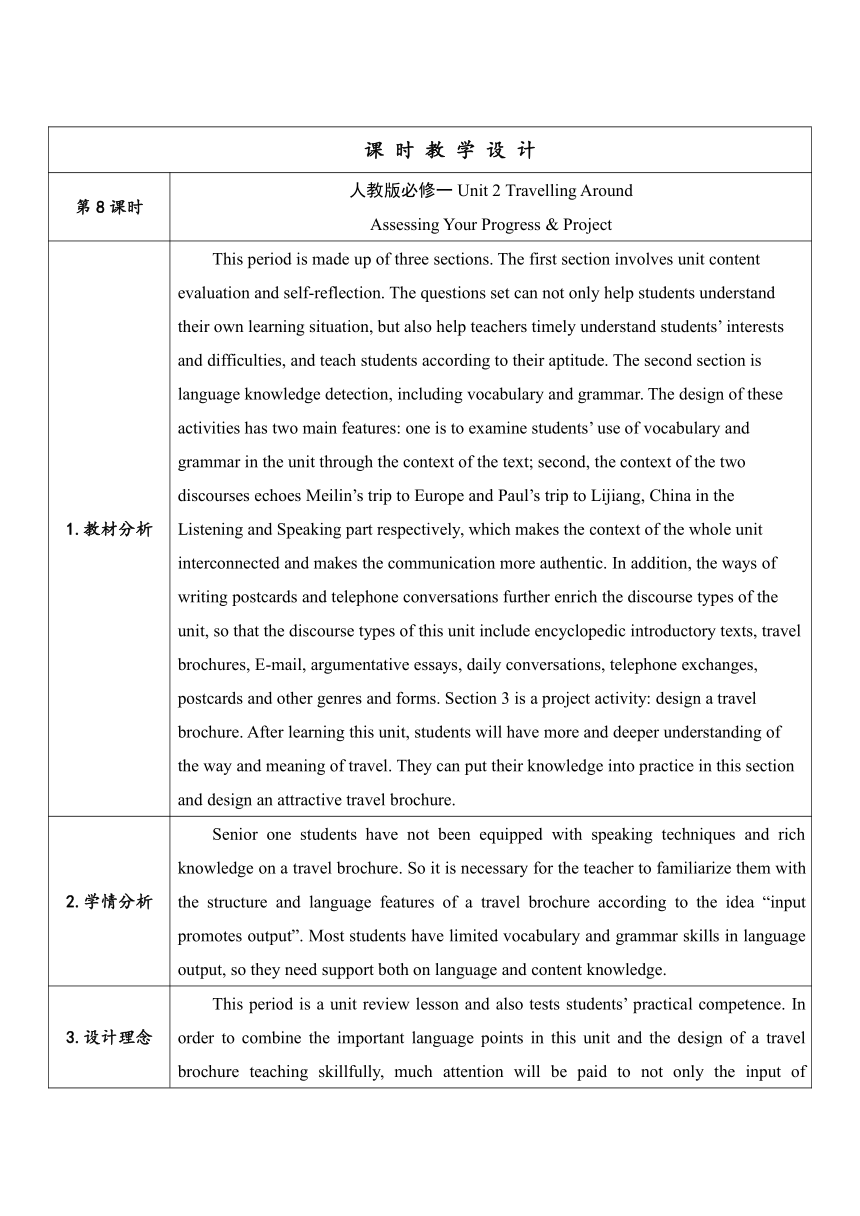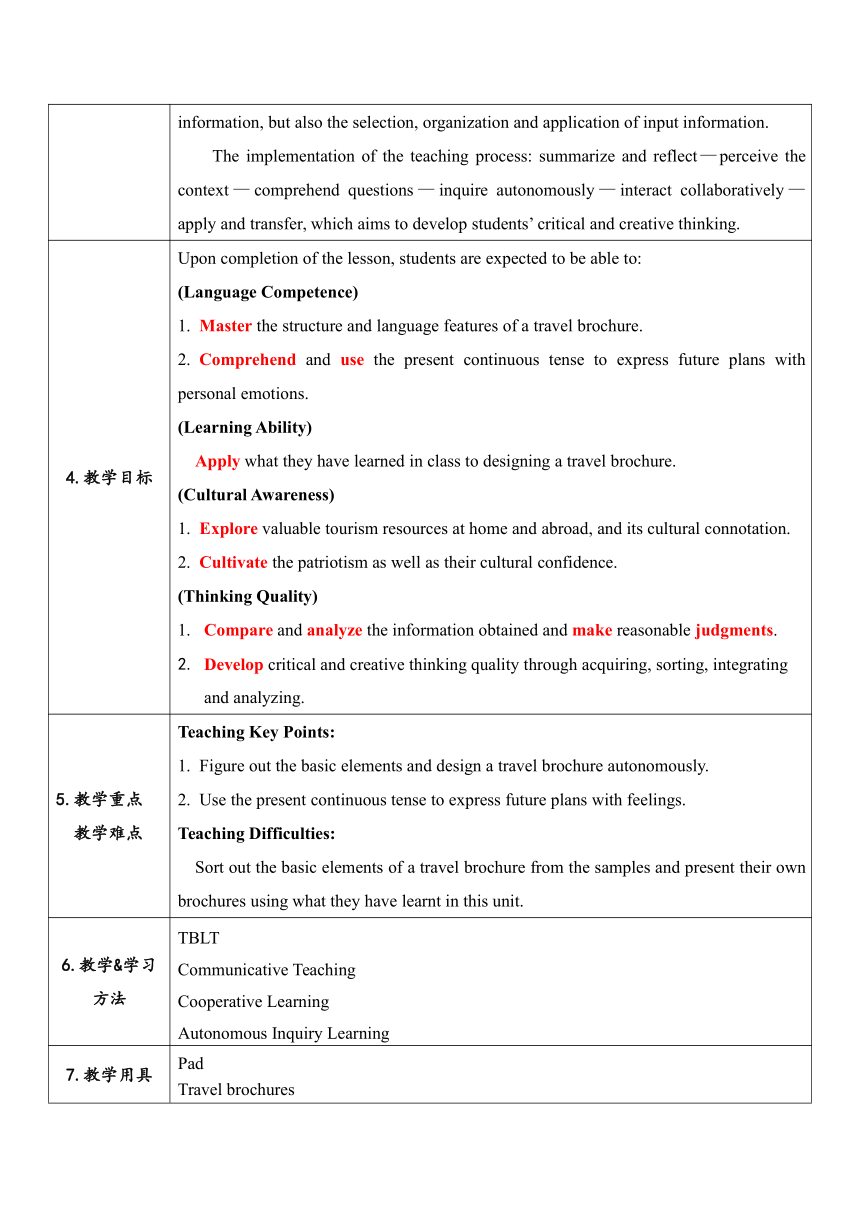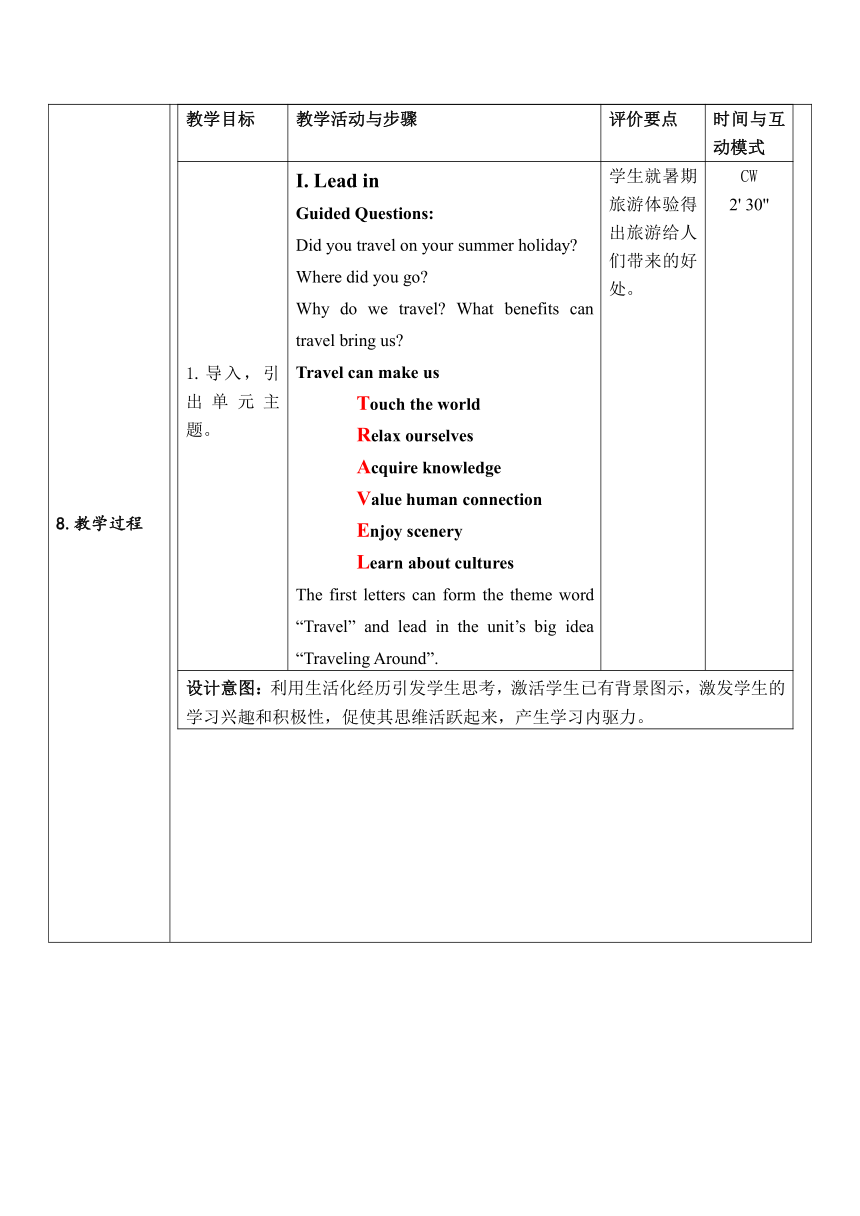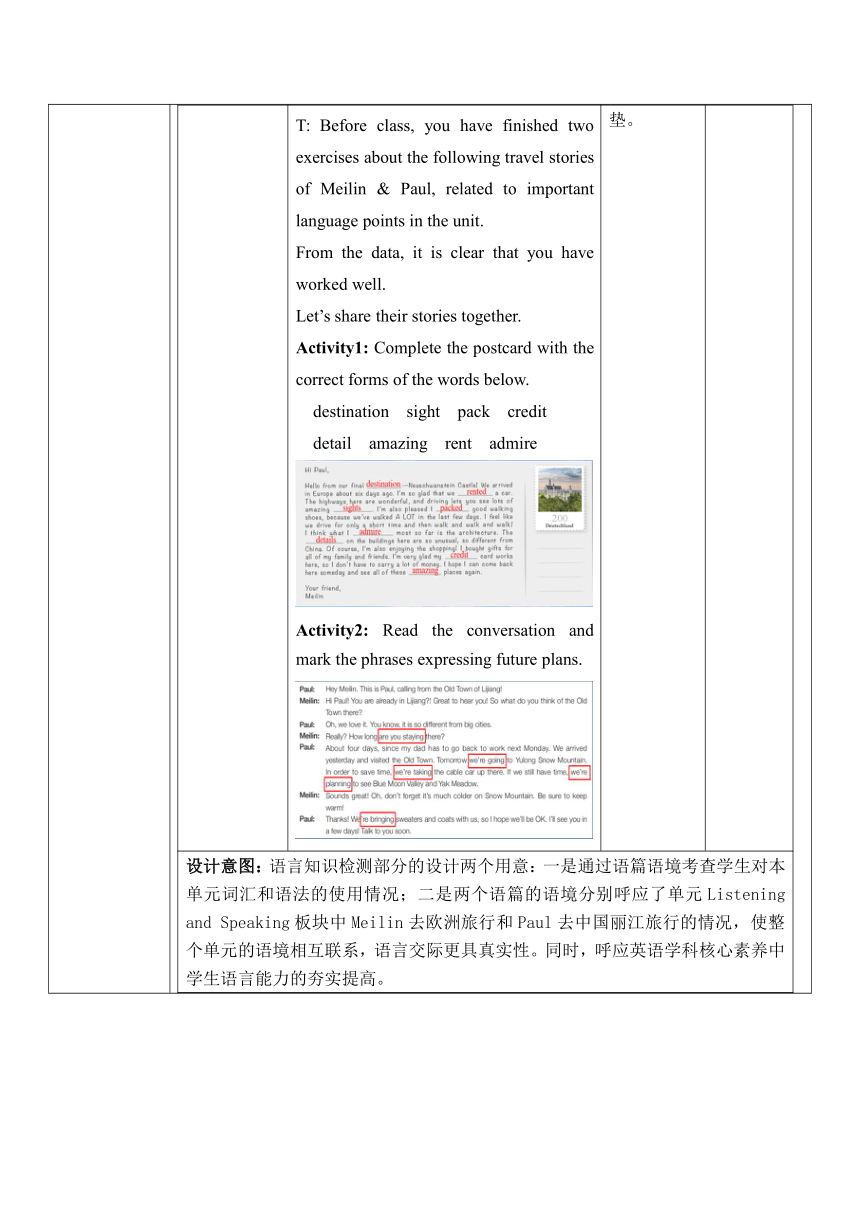人教版(2019)必修 第一册Unit 2 Travelling Around Assessing your progress & Project 教学设计(表格式)
文档属性
| 名称 | 人教版(2019)必修 第一册Unit 2 Travelling Around Assessing your progress & Project 教学设计(表格式) |  | |
| 格式 | docx | ||
| 文件大小 | 415.0KB | ||
| 资源类型 | 教案 | ||
| 版本资源 | 人教版(2019) | ||
| 科目 | 英语 | ||
| 更新时间 | 2025-02-06 16:00:48 | ||
图片预览





文档简介
课 时 教 学 设 计
第8课时 人教版必修一Unit 2 Travelling Around Assessing Your Progress & Project
1.教材分析 This period is made up of three sections. The first section involves unit content evaluation and self-reflection. The questions set can not only help students understand their own learning situation, but also help teachers timely understand students’ interests and difficulties, and teach students according to their aptitude. The second section is language knowledge detection, including vocabulary and grammar. The design of these activities has two main features: one is to examine students’ use of vocabulary and grammar in the unit through the context of the text; second, the context of the two discourses echoes Meilin’s trip to Europe and Paul’s trip to Lijiang, China in the Listening and Speaking part respectively, which makes the context of the whole unit interconnected and makes the communication more authentic. In addition, the ways of writing postcards and telephone conversations further enrich the discourse types of the unit, so that the discourse types of this unit include encyclopedic introductory texts, travel brochures, E-mail, argumentative essays, daily conversations, telephone exchanges, postcards and other genres and forms. Section 3 is a project activity: design a travel brochure. After learning this unit, students will have more and deeper understanding of the way and meaning of travel. They can put their knowledge into practice in this section and design an attractive travel brochure.
2.学情分析 Senior one students have not been equipped with speaking techniques and rich knowledge on a travel brochure. So it is necessary for the teacher to familiarize them with the structure and language features of a travel brochure according to the idea “input promotes output”. Most students have limited vocabulary and grammar skills in language output, so they need support both on language and content knowledge.
3.设计理念 This period is a unit review lesson and also tests students’ practical competence. In order to combine the important language points in this unit and the design of a travel brochure teaching skillfully, much attention will be paid to not only the input of information, but also the selection, organization and application of input information. The implementation of the teaching process: summarize and reflect—perceive the context—comprehend questions—inquire autonomously—interact collaboratively—apply and transfer, which aims to develop students’ critical and creative thinking.
4.教学目标 Upon completion of the lesson, students are expected to be able to: (Language Competence) Master the structure and language features of a travel prehend and use the present continuous tense to express future plans with personal emotions. (Learning Ability) Apply what they have learned in class to designing a travel brochure. (Cultural Awareness) Explore valuable tourism resources at home and abroad, and its cultural connotation. Cultivate the patriotism as well as their cultural confidence. (Thinking Quality) Compare and analyze the information obtained and make reasonable judgments. Develop critical and creative thinking quality through acquiring, sorting, integrating and analyzing.
5.教学重点 教学难点 Teaching Key Points: Figure out the basic elements and design a travel brochure autonomously. Use the present continuous tense to express future plans with feelings. Teaching Difficulties: Sort out the basic elements of a travel brochure from the samples and present their own brochures using what they have learnt in this unit.
6.教学&学习方法 TBLT Communicative Teaching Cooperative Learning Autonomous Inquiry Learning
7.教学用具 Pad Travel brochures
8.教学过程 教学目标教学活动与步骤评价要点时间与互动模式 1.导入,引出单元主题。I. Lead in Guided Questions: Did you travel on your summer holiday Where did you go Why do we travel What benefits can travel bring us Travel can make us Touch the world Relax ourselves Acquire knowledge Value human connection Enjoy scenery Learn about cultures The first letters can form the theme word “Travel” and lead in the unit’s big idea “Traveling Around”.学生就暑期旅游体验得出旅游给人们带来的好处。CW 2' 30''设计意图:利用生活化经历引发学生思考,激活学生已有背景图示,激发学生的学习兴趣和积极性,促使其思维活跃起来,产生学习内驱力。 2.单元内容回顾评价& 自我反思。 II. Reflecting Guided Questions: Overall, what do you think of this unit —Useful Cool Just OK Difficult What have you got from the unit What about language points on travel Can you list some expressions of emotion on travel —amazing, unbelievable, incredible, can’t wait to do, one’s dream destination... Are there any verbs used to express future action in the form of “be doing” —be going, be visiting, be taking, be checking in, be leaving for home... 学生整体评价本单元学习收获颇多、单元实用性很强。 学生能够回顾本单元重点词汇、语法,为后续项目活动设下语言铺垫。CW 4' 30''设计意图:单元评价帮助学生回顾本单元的学习掌握情况,帮助教师及时了解学生的兴趣点和困难,因材施教。同时,学生再现单元重点词汇、语法,为后续项目活动埋下语言伏笔。 3.单元重点词汇、语法检测。III. Self-assessing Guided Instructions: T: Class, there are two persons Meilin & Paul in the unit. Do you remember them It has mentioned their travel stories in the Listening and Speaking section, let’s pay attention to the following stories of Meilin and Paul right now. T: Before class, you have finished two exercises about the following travel stories of Meilin & Paul, related to important language points in the unit. From the data, it is clear that you have worked well. Let’s share their stories together. Activity1: Complete the postcard with the correct forms of the words below. destination sight pack credit detail amazing rent admire Activity2: Read the conversation and mark the phrases expressing future plans. 学生课前完成教师线上发布的练习活动,通过完成情况的数据显示,可知学生对于本单元重点词汇、语法掌握较好,再次夯实语言知识,为后续项目活动设下语言铺垫。IW 2'设计意图:语言知识检测部分的设计两个用意:一是通过语篇语境考查学生对本单元词汇和语法的使用情况;二是两个语篇的语境分别呼应了单元Listening and Speaking板块中Meilin去欧洲旅行和Paul去中国丽江旅行的情况,使整个单元的语境相互联系,语言交际更具真实性。同时,呼应英语学科核心素养中学生语言能力的夯实提高。 4.项目活动:设计旅游宣传册。 通过本单元的学习,学以致用,设计一份具有吸引力的旅游宣传册。Ⅳ. Project: Design a travel brochure Activity 1: Brainstorm Guided Instructions: T: After knowing Meilin & Paul’s trips, what other types of tours do you know Let’s watch a video to brainstorm different kinds of tours you know. —Travel for education, history, adventure, culture, business, weekend getaway, honeymoon, sightseeing, cuisine, study...学生通过观看关于旅行类别的视频,头脑风暴列举不同种类的旅游类型,引出Project中的posts。CW/PW 3' 05''Guided Questions: Among these different kinds of trips, what about them There are three foreign students(Fraser, Anthony, Anna) who will come to our China to travel or study. Activity2: Read the posts and find out what each student’s reason is for travelling. Guided Questions: Can you offer them some further information about what they favourite just like a travel agent Activity3: Work in groups of 6 and choose one person (Fraser, Anthony, Anna). Work out a one-week travel plan for him / her. 学生阅读posts提炼关键信息,明确设计方向;小组合作讨论为文本中人物制定一周旅行计划,通过“智慧课堂”信息技术平台展示学生work,层层递进、循序渐进,为后续项目输出铺路。IW/GW 7' 45''Guided Questions: Can you turn your travel plan into a travel brochure to make it more vivid and attractive What is a travel brochure How do we design a good brochure Instruct students to get what elements a good travel brochure should have by observing several travel brochures. Activity4: On the basis of activity 3, each group designs a travel brochure for the tour. Make your brochure as attractive as possible. 学生通过观察旅游宣传册实物,自主发现旅游宣传册具备要素,小组合作将制定得旅行计划丰富化、形象生动化,设计一份具有吸引力的旅游宣传册。CW/GW 8'Activity5: Present your work using the unit’s language points. Role-play a travel agent and one of the people (Fraser, Anthony, or Anna). The travel agent should explain the tour to the customer and try to sell it by explaining how wonderful the tour is. The customer should feel free to offer objections and ask questions. 学生通过角色扮演展示小组合作成果,学生的设计和呈现展示各具特色,紧扣主题。将本单元重点词汇、语法学以致用。GW 10' 50''设计意图:本环节的项目活动旨在考查学生是否可以将本单元所学在单元主题引领下学以致用。发挥学生的主体意识、主动探究意识和创造性,能够提高学生的课堂参与程度。注重培养学生分析问题、解决问题的能力以及创造性思维的培养,培养学生的高阶思维能力,以提升学科核心素养。 此活动不仅可以激发学生的学习热情和兴趣,更重要的是为学生提供运用语言的机会。让学生参与展示,发挥学生的主体性,不仅增强了学生的合作意识,还突出了英语学科的人文性。本环节将学生逻辑思维能力和创新思维能力相结合,培养学生的高阶思维能力。 5.课堂总结& 情感升华T: All of us should inherit and promote our Chinese culture. We should be extremely confident about our nation’s culture! Just as president Xi has said: Cultural confidence represents a fundamental and profound force that sustains the development of a country and a nation. 引用习近平总书记在二十大中对“文化自信”的阐述,对学生进行情感升华,培养文化自信,弘扬中国文化。注重学生文化意识的树立。CW 1'设计意图:面对学生们的作品展示和语言交流,字里行间流露出学生们对我们中国文化的自信与骄傲,对学生进行情感升华、文化意识的培养,加深文化自信。
9.板书设计 Unit 2 Travelling around Assessing Your Progress & Project Expressions on travel feelings amazing unbelievable incredible can’t wait to do ...is one’s dream destination. “be doing” expressing future be going be visiting be taking be checking in be leaving for home...
10.作业布置 Review the important language and grammar points on travelling in the unit. (15min) 进一步巩固复习本单元重点词汇、语法等语言知识,培养提高学生的语言能力和学习能力,以契合学科核心素养。 Polish the brochure and share it with your classmates. (20min) 完善作品成果,介绍给同学,锻炼提高语言综合运用能力,提升文化自信。
11.教学反思 作为整个单元最后一课时的单元复习&项目活动课,借助智慧课堂信息技术平台引导学生从单元反思—语言知识回顾—项目活动产出层层递进,逐个环节过渡。既对学生整个单元的学习情况有所掌握,又通过核心词汇、语法复现为后续项目活动输出扫除语言障碍、埋下伏笔,同时注重对学生文化自信的培养熏陶,增强文化意识。设置半开放性活动,将课堂留给学生,以供学生独立思考和自由表达,充分实践学生的自主学习、合作式探究学习,既有归纳总结,也有发散创造。有意识地设计兼具趣味性和挑战性的学习活动来培养学生的语言能力和思维能力,提高学生的语言综合运用能力。 本节课活动设计遵循英语学习活动观中所倡导的课堂模式:学习理解—应用实践—迁移创新。利用智慧课堂信息技术平台进行层层递进、环环相扣的学习活动设置,关注课堂的自然生成以及学生语言能力、学习能力、文化意识、思维品质四大核心素养的真正提升。 借助智慧课堂信息技术平台,实现教学决策数据化、评价反馈及时化、交流互动立体化、资源推送智能化。提升教师课堂教学机智,展现教师课堂教学艺术,使得师生互动、生生互动更加智能化、个性化,体现了课堂教学动态生成的特点,真正落实了培养学生学科核心素养的理念。 不足: 每个学生在项目活动环节头脑风暴、集思广益、认真准备,都想将自己的作品展示给大家,弘扬中国文化,展现文化自信。但由于课堂时间限制,未能实现全员呈现,可利用课余时间进行本节课的连载活动—旅游宣传册PK赛(角色扮演介绍作品,学生评定),给学生们提供语言表达的机会和平台,考查学生语言综合运用能力。另外,部分学生在此环节进行角色扮演展示作品的过程中,缺乏场景真实性,略显僵硬、不够自然,与学生口语表达能力欠佳有关,故在平日教学中,需注重多途径进行语言的输入积累,促进语言的有效输出,并加强练习,提高学生的语言综合运用能力。
第8课时 人教版必修一Unit 2 Travelling Around Assessing Your Progress & Project
1.教材分析 This period is made up of three sections. The first section involves unit content evaluation and self-reflection. The questions set can not only help students understand their own learning situation, but also help teachers timely understand students’ interests and difficulties, and teach students according to their aptitude. The second section is language knowledge detection, including vocabulary and grammar. The design of these activities has two main features: one is to examine students’ use of vocabulary and grammar in the unit through the context of the text; second, the context of the two discourses echoes Meilin’s trip to Europe and Paul’s trip to Lijiang, China in the Listening and Speaking part respectively, which makes the context of the whole unit interconnected and makes the communication more authentic. In addition, the ways of writing postcards and telephone conversations further enrich the discourse types of the unit, so that the discourse types of this unit include encyclopedic introductory texts, travel brochures, E-mail, argumentative essays, daily conversations, telephone exchanges, postcards and other genres and forms. Section 3 is a project activity: design a travel brochure. After learning this unit, students will have more and deeper understanding of the way and meaning of travel. They can put their knowledge into practice in this section and design an attractive travel brochure.
2.学情分析 Senior one students have not been equipped with speaking techniques and rich knowledge on a travel brochure. So it is necessary for the teacher to familiarize them with the structure and language features of a travel brochure according to the idea “input promotes output”. Most students have limited vocabulary and grammar skills in language output, so they need support both on language and content knowledge.
3.设计理念 This period is a unit review lesson and also tests students’ practical competence. In order to combine the important language points in this unit and the design of a travel brochure teaching skillfully, much attention will be paid to not only the input of information, but also the selection, organization and application of input information. The implementation of the teaching process: summarize and reflect—perceive the context—comprehend questions—inquire autonomously—interact collaboratively—apply and transfer, which aims to develop students’ critical and creative thinking.
4.教学目标 Upon completion of the lesson, students are expected to be able to: (Language Competence) Master the structure and language features of a travel prehend and use the present continuous tense to express future plans with personal emotions. (Learning Ability) Apply what they have learned in class to designing a travel brochure. (Cultural Awareness) Explore valuable tourism resources at home and abroad, and its cultural connotation. Cultivate the patriotism as well as their cultural confidence. (Thinking Quality) Compare and analyze the information obtained and make reasonable judgments. Develop critical and creative thinking quality through acquiring, sorting, integrating and analyzing.
5.教学重点 教学难点 Teaching Key Points: Figure out the basic elements and design a travel brochure autonomously. Use the present continuous tense to express future plans with feelings. Teaching Difficulties: Sort out the basic elements of a travel brochure from the samples and present their own brochures using what they have learnt in this unit.
6.教学&学习方法 TBLT Communicative Teaching Cooperative Learning Autonomous Inquiry Learning
7.教学用具 Pad Travel brochures
8.教学过程 教学目标教学活动与步骤评价要点时间与互动模式 1.导入,引出单元主题。I. Lead in Guided Questions: Did you travel on your summer holiday Where did you go Why do we travel What benefits can travel bring us Travel can make us Touch the world Relax ourselves Acquire knowledge Value human connection Enjoy scenery Learn about cultures The first letters can form the theme word “Travel” and lead in the unit’s big idea “Traveling Around”.学生就暑期旅游体验得出旅游给人们带来的好处。CW 2' 30''设计意图:利用生活化经历引发学生思考,激活学生已有背景图示,激发学生的学习兴趣和积极性,促使其思维活跃起来,产生学习内驱力。 2.单元内容回顾评价& 自我反思。 II. Reflecting Guided Questions: Overall, what do you think of this unit —Useful Cool Just OK Difficult What have you got from the unit What about language points on travel Can you list some expressions of emotion on travel —amazing, unbelievable, incredible, can’t wait to do, one’s dream destination... Are there any verbs used to express future action in the form of “be doing” —be going, be visiting, be taking, be checking in, be leaving for home... 学生整体评价本单元学习收获颇多、单元实用性很强。 学生能够回顾本单元重点词汇、语法,为后续项目活动设下语言铺垫。CW 4' 30''设计意图:单元评价帮助学生回顾本单元的学习掌握情况,帮助教师及时了解学生的兴趣点和困难,因材施教。同时,学生再现单元重点词汇、语法,为后续项目活动埋下语言伏笔。 3.单元重点词汇、语法检测。III. Self-assessing Guided Instructions: T: Class, there are two persons Meilin & Paul in the unit. Do you remember them It has mentioned their travel stories in the Listening and Speaking section, let’s pay attention to the following stories of Meilin and Paul right now. T: Before class, you have finished two exercises about the following travel stories of Meilin & Paul, related to important language points in the unit. From the data, it is clear that you have worked well. Let’s share their stories together. Activity1: Complete the postcard with the correct forms of the words below. destination sight pack credit detail amazing rent admire Activity2: Read the conversation and mark the phrases expressing future plans. 学生课前完成教师线上发布的练习活动,通过完成情况的数据显示,可知学生对于本单元重点词汇、语法掌握较好,再次夯实语言知识,为后续项目活动设下语言铺垫。IW 2'设计意图:语言知识检测部分的设计两个用意:一是通过语篇语境考查学生对本单元词汇和语法的使用情况;二是两个语篇的语境分别呼应了单元Listening and Speaking板块中Meilin去欧洲旅行和Paul去中国丽江旅行的情况,使整个单元的语境相互联系,语言交际更具真实性。同时,呼应英语学科核心素养中学生语言能力的夯实提高。 4.项目活动:设计旅游宣传册。 通过本单元的学习,学以致用,设计一份具有吸引力的旅游宣传册。Ⅳ. Project: Design a travel brochure Activity 1: Brainstorm Guided Instructions: T: After knowing Meilin & Paul’s trips, what other types of tours do you know Let’s watch a video to brainstorm different kinds of tours you know. —Travel for education, history, adventure, culture, business, weekend getaway, honeymoon, sightseeing, cuisine, study...学生通过观看关于旅行类别的视频,头脑风暴列举不同种类的旅游类型,引出Project中的posts。CW/PW 3' 05''Guided Questions: Among these different kinds of trips, what about them There are three foreign students(Fraser, Anthony, Anna) who will come to our China to travel or study. Activity2: Read the posts and find out what each student’s reason is for travelling. Guided Questions: Can you offer them some further information about what they favourite just like a travel agent Activity3: Work in groups of 6 and choose one person (Fraser, Anthony, Anna). Work out a one-week travel plan for him / her. 学生阅读posts提炼关键信息,明确设计方向;小组合作讨论为文本中人物制定一周旅行计划,通过“智慧课堂”信息技术平台展示学生work,层层递进、循序渐进,为后续项目输出铺路。IW/GW 7' 45''Guided Questions: Can you turn your travel plan into a travel brochure to make it more vivid and attractive What is a travel brochure How do we design a good brochure Instruct students to get what elements a good travel brochure should have by observing several travel brochures. Activity4: On the basis of activity 3, each group designs a travel brochure for the tour. Make your brochure as attractive as possible. 学生通过观察旅游宣传册实物,自主发现旅游宣传册具备要素,小组合作将制定得旅行计划丰富化、形象生动化,设计一份具有吸引力的旅游宣传册。CW/GW 8'Activity5: Present your work using the unit’s language points. Role-play a travel agent and one of the people (Fraser, Anthony, or Anna). The travel agent should explain the tour to the customer and try to sell it by explaining how wonderful the tour is. The customer should feel free to offer objections and ask questions. 学生通过角色扮演展示小组合作成果,学生的设计和呈现展示各具特色,紧扣主题。将本单元重点词汇、语法学以致用。GW 10' 50''设计意图:本环节的项目活动旨在考查学生是否可以将本单元所学在单元主题引领下学以致用。发挥学生的主体意识、主动探究意识和创造性,能够提高学生的课堂参与程度。注重培养学生分析问题、解决问题的能力以及创造性思维的培养,培养学生的高阶思维能力,以提升学科核心素养。 此活动不仅可以激发学生的学习热情和兴趣,更重要的是为学生提供运用语言的机会。让学生参与展示,发挥学生的主体性,不仅增强了学生的合作意识,还突出了英语学科的人文性。本环节将学生逻辑思维能力和创新思维能力相结合,培养学生的高阶思维能力。 5.课堂总结& 情感升华T: All of us should inherit and promote our Chinese culture. We should be extremely confident about our nation’s culture! Just as president Xi has said: Cultural confidence represents a fundamental and profound force that sustains the development of a country and a nation. 引用习近平总书记在二十大中对“文化自信”的阐述,对学生进行情感升华,培养文化自信,弘扬中国文化。注重学生文化意识的树立。CW 1'设计意图:面对学生们的作品展示和语言交流,字里行间流露出学生们对我们中国文化的自信与骄傲,对学生进行情感升华、文化意识的培养,加深文化自信。
9.板书设计 Unit 2 Travelling around Assessing Your Progress & Project Expressions on travel feelings amazing unbelievable incredible can’t wait to do ...is one’s dream destination. “be doing” expressing future be going be visiting be taking be checking in be leaving for home...
10.作业布置 Review the important language and grammar points on travelling in the unit. (15min) 进一步巩固复习本单元重点词汇、语法等语言知识,培养提高学生的语言能力和学习能力,以契合学科核心素养。 Polish the brochure and share it with your classmates. (20min) 完善作品成果,介绍给同学,锻炼提高语言综合运用能力,提升文化自信。
11.教学反思 作为整个单元最后一课时的单元复习&项目活动课,借助智慧课堂信息技术平台引导学生从单元反思—语言知识回顾—项目活动产出层层递进,逐个环节过渡。既对学生整个单元的学习情况有所掌握,又通过核心词汇、语法复现为后续项目活动输出扫除语言障碍、埋下伏笔,同时注重对学生文化自信的培养熏陶,增强文化意识。设置半开放性活动,将课堂留给学生,以供学生独立思考和自由表达,充分实践学生的自主学习、合作式探究学习,既有归纳总结,也有发散创造。有意识地设计兼具趣味性和挑战性的学习活动来培养学生的语言能力和思维能力,提高学生的语言综合运用能力。 本节课活动设计遵循英语学习活动观中所倡导的课堂模式:学习理解—应用实践—迁移创新。利用智慧课堂信息技术平台进行层层递进、环环相扣的学习活动设置,关注课堂的自然生成以及学生语言能力、学习能力、文化意识、思维品质四大核心素养的真正提升。 借助智慧课堂信息技术平台,实现教学决策数据化、评价反馈及时化、交流互动立体化、资源推送智能化。提升教师课堂教学机智,展现教师课堂教学艺术,使得师生互动、生生互动更加智能化、个性化,体现了课堂教学动态生成的特点,真正落实了培养学生学科核心素养的理念。 不足: 每个学生在项目活动环节头脑风暴、集思广益、认真准备,都想将自己的作品展示给大家,弘扬中国文化,展现文化自信。但由于课堂时间限制,未能实现全员呈现,可利用课余时间进行本节课的连载活动—旅游宣传册PK赛(角色扮演介绍作品,学生评定),给学生们提供语言表达的机会和平台,考查学生语言综合运用能力。另外,部分学生在此环节进行角色扮演展示作品的过程中,缺乏场景真实性,略显僵硬、不够自然,与学生口语表达能力欠佳有关,故在平日教学中,需注重多途径进行语言的输入积累,促进语言的有效输出,并加强练习,提高学生的语言综合运用能力。
